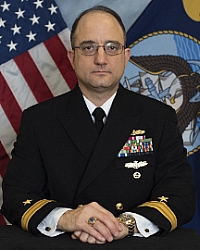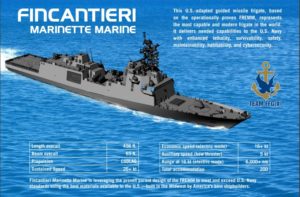The head of the Navy office that develops, builds, and maintains unmanned and small surface combatants underscored the future frigate, FFG(X), will be an Aegis Frigate and is optimistic they will work out a solution with Congress on domestic sourcing of combatant equipment.
The Navy is currently undergoing source selection for the detail design and construction (DD&C) competition of the frigate, which the Navy plans to succeed the Littoral Combat Ships to round out the small surface combatant fleet. The Navy plans to eventually procure 20 frigates, although the initial DD&C will award a contract for the first 10 vessels.

Program Executive Officer, Unmanned and Small Combatants (Photo: U.S. Navy)
In June, the Navy issued the final request for proposals for DD&C for the frigates and expects to award a single winner in FY 2020.
Rear Adm. Casey Moton, Program Executive Officer Unmanned and Small Combatants (PEO USC), said he is excited about the frigate capability.
“We haven’t really used the term very much publicly, I’m not sure why but these are Aegis Frigates. They’re going to have an Aegis Combat Systems Baseline and they’re going to be operating with an [Enterprise Air Surveillance Radar (EASR)], MK-41 [vertical launch system],” and more.
“These are Aegis Frigates, make no mistake about it,” he continued.
Moton also said the previous conceptual design (CD) contracts with five companies, which finished earlier this year, was a success. In February 2018, the Navy awarded five $15 million CD contracts to help industry mature their designs to more quickly meet the Navy’s capability requirements (Defense Daily, Feb. 16, 2018).
The five awardees were Austal USA, Huntington Ingalls Industries [HII], Lockheed Martin [LMT], Fincantieri’s Marinette Marine, and General Dynamics’ Bath Iron Works [GD]. In May, Lockheed Martin said it decided not to pursue the FFG(X) any further, instead focusing solely on the ship’s combat system (Defense Daily, May 29)
Moton said he thought the CD “was a great process, every company has told me they thought it was a good process as far as the Navy getting closely involved with industry, helping to mature their designs, being able to have a back and forth on requirements that I think everybody applauded the design. Every company is probably also told me something about final frigate requirements that they don’t like.”
“But I think we’re on a great path and very excited about coming through that frigate decision.”

However, he reiterated a point the Navy’s top acquisition official, Assistant Secretary of the Navy James Geurts, told reporters last week about a longer-term continuing resolution [CR] from Congress (Defense Daily, Nov. 15).
“A CR would actually stop us from awarding unless we had an anomaly. So obviously we’re having discussions with the Pentagon and the Hill and that’s obviously wrapped up into the broader perspective in this town. But the frigate is dependent on the appropriation,” Moton said.
He also noted the Navy is having a “robust discussion” with the Hill about domestic sourcing for the frigate.
The House Appropriations Committee’s FY 2020 defense appropriations bill has Buy America provisions that requires parts to be produced in America by American companies, specifically combatant equipment.
In June, the House Armed Services Committee’s Seapower subcommittee adopted an en block amendment from Rep. Mike Gallagher (R-Wis.) for the defense authorization bill that authorizes the FFG(X) program to award a contract that does not domestically source propulsion or certain auxiliary equipment (Defense Daily, June 4).
At the time, Gallagher explained Congress in recent years has only imposed that restriction on auxiliary vessels and not warships like frigates or destroyers. A Buy America provision could exclude some of the competitors, increase costs, and cause at least a year-long delay in construction. Subcommittee Chairman Joe Courtney (D-Conn.) agreed that kind of provision might force the Navy to start a new big requirement after source selection is underway.
Moton said he thinks the Navy shares the overall Buy America objective, “which is you would like to see a more robust domestic industrial base for equipment. We are working with them to figure out a way to move to that objective that also allows us to keep frigate on schedule. We’re having good doscussions with the Hill.”
“I honestly think that they get that we’re serious, that we agree with them in terms of the objective and we’re having good discussions about how to implement it,” he added.